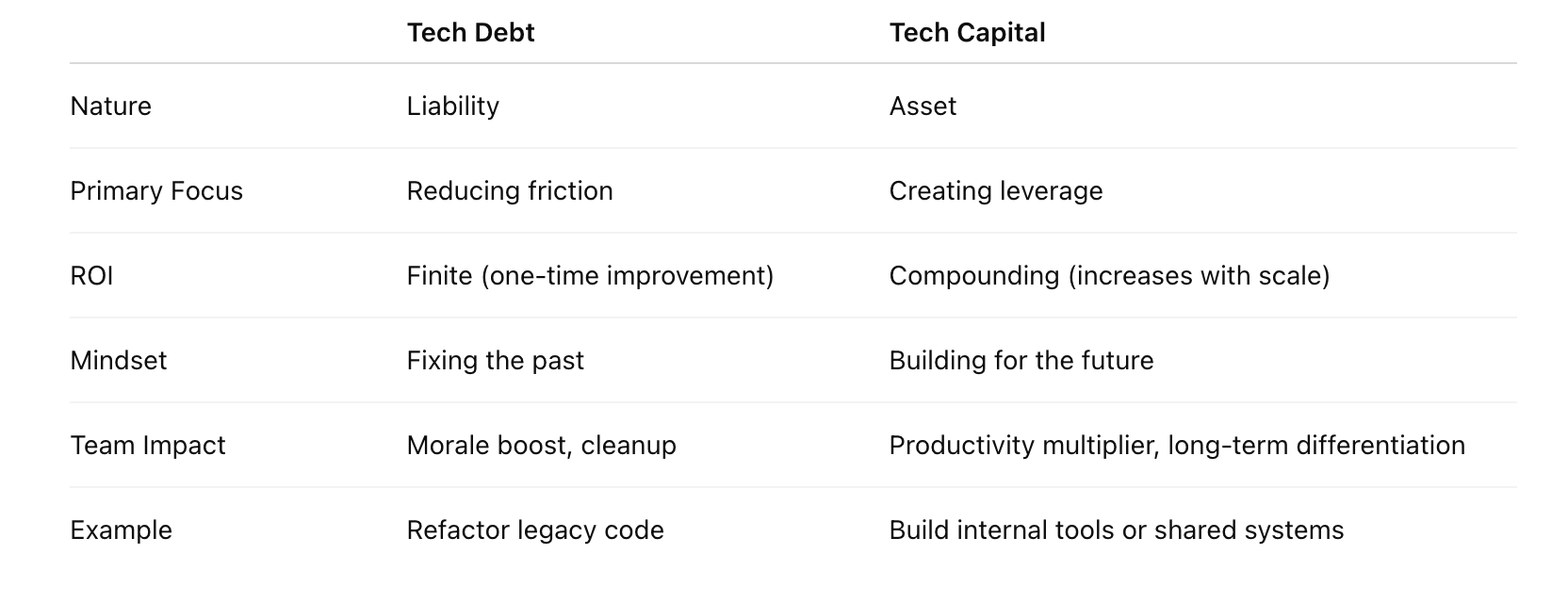Tech Debt vs. Tech Capital: The Shift That Grows Engineering Teams
Fixing tech debt might feel productive — but it won’t make your company win. The real competitive edge? Tech capital.
Most engineering teams are deeply familiar with technical debt. It’s part of the job — the messy architecture that slows you down, the legacy code you dread touching, the tooling that’s long overdue for replacement.
And for good reason, tech debt matters. It creates friction, hampers velocity, and erodes developer morale.
But here’s the catch:
Tech debt is a capped problem.
You can only refactor so much. You can only clean so many messes. And once you do, the upside is… done.
If all your team does is fix the past, you’re not actually building the future.
That’s where tech capital comes in.
Tech Debt vs. Tech Capital
If tech debt is a liability, tech capital is an asset.
It’s the set of engineering investments that compound over time — making your organization stronger, faster, and more resilient as you scale.
Let’s break down the difference:
Tech Debt & Tech Capital

Why Tech Capital Matters
Too often, engineering teams fall into what we call the Productivity Trap: refactoring code to feel useful — without actually moving the business forward.
Here’s why a tech capital mindset leads to better outcomes:
- It scales with the company. A great internal tool doesn’t just help today — it helps every future teammate.
- It creates leverage. One small investment can unlock speed or insights across departments.
- It compounds over time. Tech capital becomes more valuable as your user base, data, and org complexity grow.
Examples of Tech Capital
Here are 3 proven ways high-performing teams build tech capital:
⚡Developer Experience (DX)
Investing in better tooling, CI/CD pipelines, and local dev environments doesn't just make engineers happier — it helps them ship faster and safer. That’s capital.
🦸 Internal Superpowers
Build tools that unblock other teams:
- Dashboards for sales
- Self-serve analytics for marketing
- Automation for support
These aren’t features — they’re force multipliers.
📊 Data Leverage
Go beyond collecting data. Use it. Build systems that:
- Generate unique insights
- Power personalized user experiences
- Unlock new business models
When data becomes a strategic asset, it’s tech capital at work.
🚀 Shifting the Mindset
You don’t need permission to build tech capital. Start small:
- Document something once and share it.
- Automate a painful internal task.
- Build a service that saves engineers 10 minutes every day.
- Build components
Over time, these investments snowball — and become your team’s greatest competitive edge.
Conclusion
Refactoring matters. But it’s not enough.
Fixing the past doesn’t drive the future.
Tech capital is how you scale with speed, not just survive with structure.
Start building leverage — and let the compounding begin.




